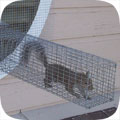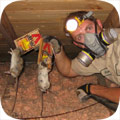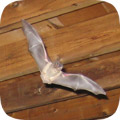- anderson@wildlifeanimalcontrol.com
Call 24/7 for a free quote:
317-451-4835
Anderson Wildlife Animal Control
Professional Wildlife Removal Company Servicing Anderson, IN
If you have a problem with wildlife in your Anderson home, your best option is to hire a company that specializes in Indiana wildlife removal only. This is a specialty business, and regular pest control companies do not use the proper techniques to solve animal problems. I have spent many years reviewing Indiana and Anderson, and I recommend the following:
Varment Guard Wildlife Services
Cell Phone: 317-451-4835
NOTE: If you have a dog or cat problem, call Madison County Animal Services: (765) 356-0900

Varment Guard Wildlife Services specializes primarily in removing animals from attics of homes and buildings - this includes squirrels in attics, raccoons, and rats or mice in homes. Indiana also has a documented problem with
bats in buildings, and Varment Guard Wildlife Services is specially trained in bat removal. They also perform general wildlife trapping services, such as the capture and removal of skunks or opossums on the
property. Call 317-451-4835 to discuss your critter problem and schedule a same-day or next-day appointment. Click here to learn more about
what prices we charge in 2022.
When hiring a company to solve your wild animal problem, you want these features:
- Specializes in wildlife removal, not pest control
- Fully Indiana and Madison County licensed and insured
- Works 7 days per week (critters don't take weekends off)
- Performs full building inspections: enters and inspects attic
- Performs exclusion repairs, with guarantee against animal re-entry
- Offers cleanup of biohazardous wildlife waste
Varment Guard Wildlife Services is a full-service Anderson wildlife removal company. This is very different from a regular Anderson pest control company. The pest control companies spray poison to kill insects. This is not at all
similar to wildlife removal. Varment Guard Wildlife Services performs a full inspection of the home or property, and determines why the animal(s) are there, and if inside a building, how the animals got inside. All
animals (including rodents) are trapped and removed, or if possible, removed from the building using special exclusion devices. Once the animals are gone, preventative repairs are essential, and
cleanup is sometimes recommended.
 Anderson wildlife trapping - it's not as simple as it may seem. It's illegal in Indiana to trap without a license. Trap type is very important and there are many different types, bait is somewhat relevant, trap placement
is vital, and there are dozens of small things that are very important to know.
Safety is a concern. Then once the animal is trapped, it must be removed and dealt with in the proper manner according to Indiana law. We offer Anderson raccoon removal. Read more about how to get rid of raccoons.
Anderson wildlife trapping - it's not as simple as it may seem. It's illegal in Indiana to trap without a license. Trap type is very important and there are many different types, bait is somewhat relevant, trap placement
is vital, and there are dozens of small things that are very important to know.
Safety is a concern. Then once the animal is trapped, it must be removed and dealt with in the proper manner according to Indiana law. We offer Anderson raccoon removal. Read more about how to get rid of raccoons.
 Animals in attics - this is our specialty at Varment Guard Wildlife Services. Many types of animals like to live in attics. This includes squirrels, raccoons, rats, mice, bats, birds, and even possums. Critters like to go into attics for a safe place to live
and raise their young. Removing animals from attics is very complex work, partly because of the presence of baby animals. If you need Anderson squirrel removal, we can remove all the squirrels from your attic, and seal out any future ones. Read more about how to get rid of squirrels.
Animals in attics - this is our specialty at Varment Guard Wildlife Services. Many types of animals like to live in attics. This includes squirrels, raccoons, rats, mice, bats, birds, and even possums. Critters like to go into attics for a safe place to live
and raise their young. Removing animals from attics is very complex work, partly because of the presence of baby animals. If you need Anderson squirrel removal, we can remove all the squirrels from your attic, and seal out any future ones. Read more about how to get rid of squirrels.
 Rodent control must be done in a very specific way. First off, the most important thing is that all the openings that rats and mice can use to enter a house be sealed. Then all the rodents must be physically trapped and removed.
Never, ever use poison! Most Anderson exterminators will just use this lazy poison technique to kill rodents, and it causes more harm than good - dead stinky rats, and it doesn't solve the problem. Call us for correct Anderson rat removal. Read more about how to get rid of rats.
Rodent control must be done in a very specific way. First off, the most important thing is that all the openings that rats and mice can use to enter a house be sealed. Then all the rodents must be physically trapped and removed.
Never, ever use poison! Most Anderson exterminators will just use this lazy poison technique to kill rodents, and it causes more harm than good - dead stinky rats, and it doesn't solve the problem. Call us for correct Anderson rat removal. Read more about how to get rid of rats.
 Bat removal is a highly specialized task. Indiana is known to have colonizing bats who often live in buildings. Bats love attics. If not removed, the colony can grow to a very large size over the years. The bat droppings are often corrosive and
cause health risks. The same goes for bird droppings on or in buildings. We perform Anderson pigeon removal and bird control. But our specialty is Anderson bat removal. We remove 100% of the bat colony and seal the building so that it's totally bat-proof. Read more about how to get rid of bats.
Bat removal is a highly specialized task. Indiana is known to have colonizing bats who often live in buildings. Bats love attics. If not removed, the colony can grow to a very large size over the years. The bat droppings are often corrosive and
cause health risks. The same goes for bird droppings on or in buildings. We perform Anderson pigeon removal and bird control. But our specialty is Anderson bat removal. We remove 100% of the bat colony and seal the building so that it's totally bat-proof. Read more about how to get rid of bats.
 If you have animals inside a house, no job is complete without proper exclusion repairs. If you simply hire a Anderson trapper who only removes the critters, then the problem will return. You need to hire a Anderson wildlife control company that identifies 100% of the animal entry points
into your building, and seals them shut with professional repairs. In addition, in many cases animals have left waste or contamination behind, and you'll want a company that can provide professional cleaning services. Varment Guard Wildlife Services does both.
If you have animals inside a house, no job is complete without proper exclusion repairs. If you simply hire a Anderson trapper who only removes the critters, then the problem will return. You need to hire a Anderson wildlife control company that identifies 100% of the animal entry points
into your building, and seals them shut with professional repairs. In addition, in many cases animals have left waste or contamination behind, and you'll want a company that can provide professional cleaning services. Varment Guard Wildlife Services does both.
The above are just some of the services offered by Varment Guard Wildlife Services. We also trap and remove animals that destroy lawns, such as moles, or digging animals. Sometimes animals like opossums will live under buildings, steal pet food, raid garbage cans, etc.
Read about how to get rid of opossums. Skunks commonly live under sheds or decks, and set up a den. We can trap and remove them without them spraying. Read about how to get rid of skunks. Varment Guard Wildlife Services
also provides dead animal removal in Anderson. If you need help with any other wildlife conflict, from a fox, beaver, groundhog, or any other critter, we can solve it. We also do Anderson snake removal - most of the snakes in Indiana are not venomous, but
call us if you want safe removal, or read about how to get rid of snakes in Anderson. And remember, we are a private business, not Madison County Animal Control Services, so if you have a dog or cat problem, call the County at (765) 356-0900.
Madison County animal services does not handle any wildlife issues.
Varment Guard Wildlife Services: 317-451-4835
Anderson Pricing Info For Year 2022
 Every wildlife removal situation is different, from the species of animals involved, the location of the animal inside a house or outside, the extent of repairs or cleanup, etc. It's impossible to give one-size-fits-all prices. Examples MIGHT include:
Every wildlife removal situation is different, from the species of animals involved, the location of the animal inside a house or outside, the extent of repairs or cleanup, etc. It's impossible to give one-size-fits-all prices. Examples MIGHT include:
Small Job: For example, a one-stop job to remove an animal in the yard: $100 on up
Medium Job: For example, getting critters out of your house with minor repairs: $300 on up
Large Job: For example, a project involving many service trips and complex work: $500 on up
Give us a phone call now and tell us about your wildlife issue and we will be able to give you a price estimate over the phone. If you're cool with it, we can schedule a same-day or next-day appointment if you like. Our prices are fair, and a good value because we do the job right, the first time.
Anderson Wildlife Tip #1:
The Corn Snake: Appearance, biology, life cycle, habitat, diet, behavior
The corn snake is a style of rat snake that is able to subdue its prey by constricting its body around the animal and tell it is able to literally crush the life out of it. This is an odd way for these snakes to react, as they are some of the least aggressive that you will find in this group of reptiles. They are frequently reluctant to bite, and don't seek to be aggressive with other animals, frequently choosing to run away, to slither away is more like it, than to stick around and pick a fight.
The snakes are somewhere between two and 6 feet in length, and live to be about eight years. Those who have been held in captivity have lived as long as 23 years. They have very slender builds, and bright colors on them, that makes them distinguishable from every other kind of snake except for the copperhead.
The place where the snakes are most likely to be found is in areas where there is a great deal of foliage. This means you are likely to find them in overgrown fields, forest areas, farmland, and even in buildings that are rarely used by people. They are extremely agile, being able to climb trees, cliffs, and other surfaces that are elevated. They are found mostly in the southeastern portion of the United States, ranging from the southern tip of Florida, all the way up the East Coast to areas like New Jersey and New York. However, they also expand further west, with many populations being seen in areas like Texas.
In areas where it can be bitterly cold air in the wintertime, the snakes will hibernate. In warmer climates, like Texas or Louisiana, they do not do this. They may be less active during these months but do not hibernate.
The corn snake has one of the easiest courtship processes among the snake species. It begins with a period known as a brumation, which lasts between 60 to 90 days. During this period, both the male and female prepare themselves for courtship. This can lead to decreased eating, less activity, and more time sitting in the sun.
Once the Brumation has ended, the mail will release a series of pheromones, as does the female, that not only leads to attraction, but also warns other males to stay away. If the female happens to be ovulating at the time of copulation, the eggs will be fertilized immediately. However, if she is not ovulating, then the semen is stored in a special gland inside the corn snake, which can then be used to fertilize eggs later on. A female can hang on to the semen for up to a year's period of time.
The female will lay between 12 and 24 eggs, which are usually hidden in some location where she can protect them while keeping them warm. About 10 weeks after the eggs have been laid, the young will begin to bite their way out of the shell using a special scale known as the egg tooth. This cuts a spot in the shell to enable the snake to get out.
Anderson Wildlife Tip #2:
Indiana Wildlife Information:
Indiana State bird: Northern cardinal
State fish: Largemouth bass
Indiana is one of the larger states in the country, and it was sculpted millions of years ago by receding glaciers. The part of the state formed in this manner is full of rich soil, ideal for farming. Because the state is primarily rolling hills and flat plains, agriculture is the main focus of many people living in the region. Not surprisingly, farming brings with it a slew of animals that like to live off of crops. Probably the most detrimental of these species is the prairie dog. With an extensive network of tunnels, the smart mammal can inadvertently compromise structural integrity of buildings or cause machines to get stuck out in fields. If farmers are really unlucky, livestock, like cows, will get their legs stuck in the holes. A cow with a broken legs rarely recovers and lives another day.
But prairie dogs aren't the only creatures on the lookout for fields of crops. Wild hogs are problematic in Indiana. The large combative pigs only have a few natural predators: coyotes and cougars. The mountain lion won't eat a pig a day; if anything, it might eat a pig a week. Such a limited diet does nothing for population control. Coyotes are more apt to eat a number of pigs, but the hogs are so fierce, it would take a sizeable pack to run one down. Humans have been incorporated into the process of controlling these swine, and open seasons for hunting are common.
If the hogs and the prairie dogs don't get the farmers, the birds just might. Crop fields are favorite places for flocks of birds to congregate and eat seed. Most fields are so large and densely planted that a few crows or geese can't hurt them, but private farmers can lose an entire crop to over-zealous geese.
Even though there are no real mountains in this state, there are a number of deep stream ravines. These regions have allowed beavers to flourish, and the more pools the beavers create, the more animals like muskrats, blue herons, and frogs will be seen.
Indiana only has four venomous snakes, two of which are species of rattle snakes. The other two venomous snakes are copperheads and cottonmouths. There are 30 other non-venomous snake species in the state.
Raccoons, skunks, opossums, and squirrels are also abundant.
You can always call Varment Guard Wildlife Services, any time of day, at 317-451-4835, for a price quote for Anderson wildlife control services. I am confident that this is the best choice amongst wildlife removal companies in Anderson, IN.





































